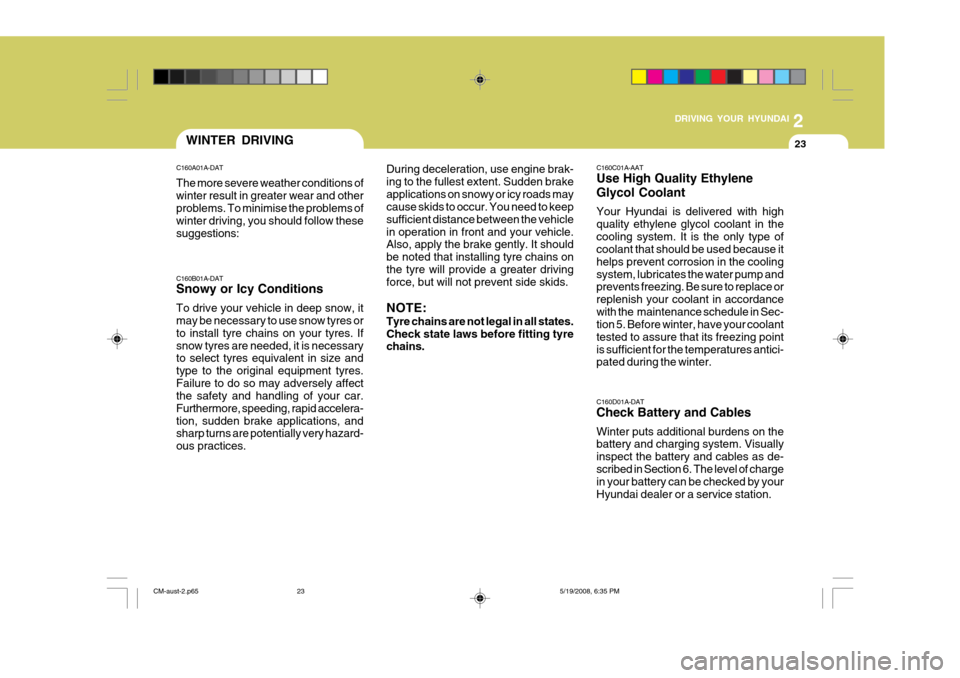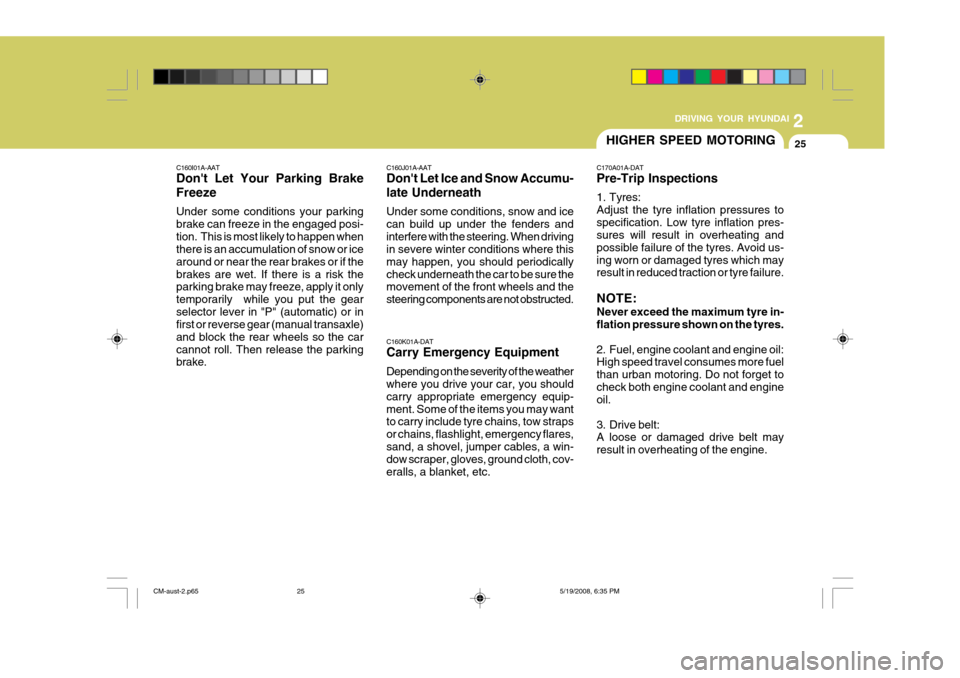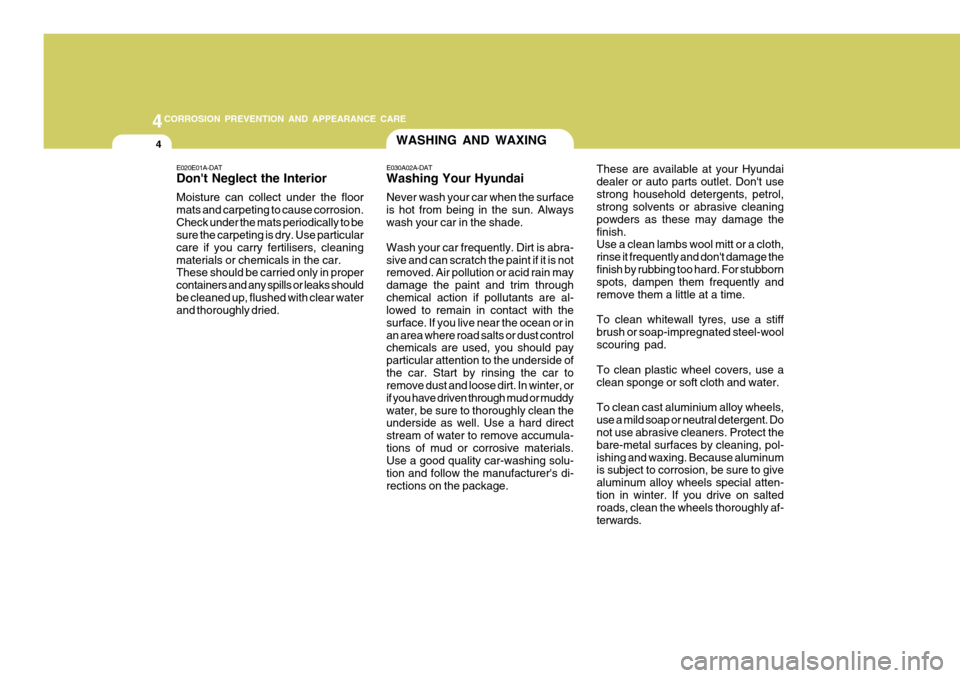winter tyres Hyundai Santa Fe 2009 Owner's Manual - RHD (UK, Australia)
[x] Cancel search | Manufacturer: HYUNDAI, Model Year: 2009, Model line: Santa Fe, Model: Hyundai Santa Fe 2009Pages: 269, PDF Size: 9.78 MB
Page 168 of 269

2
DRIVING YOUR HYUNDAI
23WINTER DRIVING
C160A01A-DAT The more severe weather conditions of winter result in greater wear and other problems. To minimise the problems of winter driving, you should follow thesesuggestions: C160C01A-AAT Use High Quality Ethylene Glycol Coolant Your Hyundai is delivered with high quality ethylene glycol coolant in thecooling system. It is the only type of coolant that should be used because it helps prevent corrosion in the coolingsystem, lubricates the water pump and prevents freezing. Be sure to replace or replenish your coolant in accordancewith the maintenance schedule in Sec- tion 5. Before winter, have your coolant tested to assure that its freezing pointis sufficient for the temperatures antici- pated during the winter.
C160B01A-DAT Snowy or Icy Conditions To drive your vehicle in deep snow, it may be necessary to use snow tyres or to install tyre chains on your tyres. If snow tyres are needed, it is necessary to select tyres equivalent in size and type to the original equipment tyres.Failure to do so may adversely affect the safety and handling of your car. Furthermore, speeding, rapid accelera-tion, sudden brake applications, and sharp turns are potentially very hazard- ous practices. During deceleration, use engine brak-ing to the fullest extent. Sudden brakeapplications on snowy or icy roads may cause skids to occur. You need to keep sufficient distance between the vehiclein operation in front and your vehicle. Also, apply the brake gently. It should be noted that installing tyre chains onthe tyre will provide a greater driving force, but will not prevent side skids. NOTE: Tyre chains are not legal in all states. Check state laws before fitting tyre chains.
C160D01A-DAT Check Battery and Cables Winter puts additional burdens on the battery and charging system. Visually inspect the battery and cables as de-scribed in Section 6. The level of charge in your battery can be checked by your Hyundai dealer or a service station.
CM-aust-2.p65 5/19/2008, 6:35 PM
23
Page 170 of 269

2
DRIVING YOUR HYUNDAI
25
C160J01A-AAT Don't Let Ice and Snow Accumu- late Underneath Under some conditions, snow and ice can build up under the fenders andinterfere with the steering. When driving in severe winter conditions where this may happen, you should periodicallycheck underneath the car to be sure the movement of the front wheels and the steering components are not obstructed. C160K01A-DAT Carry Emergency Equipment Depending on the severity of the weather where you drive your car, you should carry appropriate emergency equip-ment. Some of the items you may want to carry include tyre chains, tow straps or chains, flashlight, emergency flares,sand, a shovel, jumper cables, a win- dow scraper, gloves, ground cloth, cov- eralls, a blanket, etc.HIGHER SPEED MOTORING
C170A01A-DAT Pre-Trip Inspections
1. Tyres: Adjust the tyre inflation pressures tospecification. Low tyre inflation pres- sures will result in overheating and possible failure of the tyres. Avoid us-ing worn or damaged tyres which may result in reduced traction or tyre failure. NOTE: Never exceed the maximum tyre in- flation pressure shown on the tyres.
2. Fuel, engine coolant and engine oil: High speed travel consumes more fuel than urban motoring. Do not forget tocheck both engine coolant and engine oil.
3. Drive belt: A loose or damaged drive belt may result in overheating of the engine.
C160I01A-AAT Don't Let Your Parking Brake Freeze Under some conditions your parking brake can freeze in the engaged posi-tion. This is most likely to happen when there is an accumulation of snow or ice around or near the rear brakes or if thebrakes are wet. If there is a risk the parking brake may freeze, apply it only temporarily while you put the gearselector lever in "P" (automatic) or in first or reverse gear (manual transaxle) and block the rear wheels so the carcannot roll. Then release the parking brake.
CM-aust-2.p65
5/19/2008, 6:35 PM
25
Page 193 of 269

4CORROSION PREVENTION AND APPEARANCE CARE
4WASHING AND WAXING
E020E01A-DAT Don't Neglect the Interior Moisture can collect under the floor mats and carpeting to cause corrosion.Check under the mats periodically to be sure the carpeting is dry. Use particular care if you carry fertilisers, cleaningmaterials or chemicals in the car. These should be carried only in proper containers and any spills or leaks shouldbe cleaned up, flushed with clear water and thoroughly dried. E030A02A-DAT Washing Your Hyundai Never wash your car when the surface is hot from being in the sun. Alwayswash your car in the shade. Wash your car frequently. Dirt is abra- sive and can scratch the paint if it is not removed. Air pollution or acid rain may damage the paint and trim throughchemical action if pollutants are al- lowed to remain in contact with the surface. If you live near the ocean or inan area where road salts or dust control chemicals are used, you should pay particular attention to the underside ofthe car. Start by rinsing the car to remove dust and loose dirt. In winter, or if you have driven through mud or muddywater, be sure to thoroughly clean the underside as well. Use a hard direct stream of water to remove accumula-tions of mud or corrosive materials. Use a good quality car-washing solu- tion and follow the manufacturer's di-rections on the package. These are available at your Hyundaidealer or auto parts outlet. Don't usestrong household detergents, petrol, strong solvents or abrasive cleaning powders as these may damage thefinish. Use a clean lambs wool mitt or a cloth, rinse it frequently and don't damage thefinish by rubbing too hard. For stubborn spots, dampen them frequently and remove them a little at a time. To clean whitewall tyres, use a stiff brush or soap-impregnated steel-woolscouring pad. To clean plastic wheel covers, use a clean sponge or soft cloth and water. To clean cast aluminium alloy wheels, use a mild soap or neutral detergent. Do not use abrasive cleaners. Protect the bare-metal surfaces by cleaning, pol-ishing and waxing. Because aluminum is subject to corrosion, be sure to give aluminum alloy wheels special atten-tion in winter. If you drive on salted roads, clean the wheels thoroughly af- terwards.